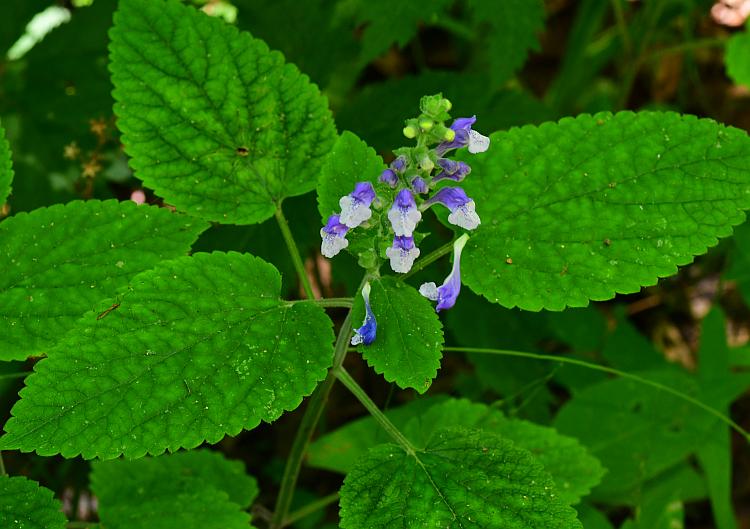Scutellaria ovata Hill
Heart-Leaved Skullcap

Native
CC = 5
CW = 3
MOC = 73
© SRTurner
Scutellaria ovata HillHeart-Leaved Skullcap | |
 |
Native CC = 5 CW = 3 MOC = 73 |
© SRTurner |
|
Family - Lamiaceae Habit - Perennial forb with slender rhizomes. Leaves - Opposite, simple, petiolate. Petioles 8-50 mm long, not winged at the tip. Leaf blades 1.5-7.0 cm long, heart-shaped to ovate or triangular-ovate, broadly rounded to truncate or cordate at the base, bluntly or more commonly sharply pointed at the tip, the margins finely to relatively coarsely toothed, the surfaces densely pubescent with relatively long, spreading to somewhat curved, multicellular, mostly gland-tipped hairs, the undersurface sometimes also with sessile glands.
Inflorescences - Slender racemes, these mostly terminal, sometimes in a cluster of 3 from the stem tip, the flowers 2 per node, solitary in the axils of bracts, the bracts 3-9 mm long, ovate to broadly ovate, sometimes finely few-toothed.
Flowers - Calyces 3-4 mm long, becoming closed and enlarged to 4-6 mm at fruiting, the outer surface densely pubescent with spreading, multicellular, mostly gland-tipped hairs. Corollas 17-25 mm long, densely pubescent with short, spreading, gland-tipped-hairs on the outer surface, pale blue to blue or bluish purple above a usually white tube, the lower lip variously white with bluish purple markings or blue to bluish purple with white and purple mottling and/or spots, the tube S-shaped (bent upward just above the calyx and strongly curved or oblique at or above the throat), lacking a ring of hairs in the throat, the lateral lobes not well-developed, ascending, the lower lip broadly fan-shaped, deeply notched at the tip.
Fruits - Persistent calyces enlarged and closed at fruiting. Nutlets 1-4 per calyx, 1.2-1.5 mm in diameter, depressed globose or broadly obovoid, the surface dark brown, densely warty or with low, rounded tubercles, these reddish brown to orangish brown.
Flowering - May - October. Habitat - Forests, glades, streambanks, bluffs, ledges, roadsides. Origin - Native to the U.S. Lookalikes - S. incana, S. elliptica. Other info. - This small but pretty species occurs across most of Missouri, except for some northwestern counties where it is rare or absent. Its main North American distribution is in the U.S. Midwest, with scattered populations extending to the Atlantic and Gulf Coasts. Photographs taken at Shaw Nature Reserve, Franklin County, MO, 6-18-2006, Taum Sauk State Park, Iron County, MO, 8-23-2009, Weldon Spring Conservation Area, St. Charles County, MO, 6-24-2011, Meramec Conservation Area, Franklin County, MO, 6-21-2013, Daniel Boone Conservation Area, Warren County, MO, 6-25-2013, and Glassberg Conservation Area, Jefferson County, MO, 6-14-2021 (SRTurner). |